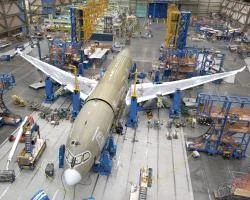Author: Benjamin Lu
Institution: Rice University
Date: August 2010
Co-Author: Nancy Wang
University of Pennsylvania
With its introduction of the new 787 Dreamliner, Boeing, the premiere airline manufacturer, hopes to revolutionize both the way commercial airlines are built and improve the way consumers fly. Aside from exceeding all existing aircrafts in comfort and cutting-edge technology, the Boeing 787 Dreamliner is unique in its utilization of composite materials. While aerospace engineers have long sought materials with the perfect combination of physical properties, Boeing's designers have found the right blend of materials that will increase fuel efficiency, decrease production waste, and expedite assembly time, all while providing a stylish and more comfortable travel vehicle.
The final assembly of the fifth Boeing 787 began early in May 2008. Delays withstanding, consumers can expect to see these aircrafts in service in late 2010. Image copyright of Boeing.
The key to Boeing's novel design is "a suite of new technologies" that are being put together for the first time. The most exciting of these technologies is the composite material. Composites are heterogeneous materials that express properties of its constituent materials. By combining different materials, the physical properties of the materials can be customized for different applications. For example, polymer-matrix composites, the type of composite used in the Dreamliner, are used in a wide variety of applications including for military aircrafts, helicopter rotor blades, tennis rackets, and circuit boards.1 The main polymer-matrix material used in the 787 Dreamliner is an epoxy matrix that integrates carbon fibers.
This combination creates a low density and therefore lightweight material that possesses substantial mechanical strength.
As evidenced by the 787 Dreamliner composite fuselage section, the use of composite materials reduces the number of components needed in the aircraft and improve the aerodynamic performance of the aircraft. The fuselage section composes of a single, full composite barrel with integrated stringers. Image copyright of Boeing.
While the inclusion of composites in the structure of aircrafts is nothing new, the Dreamliner is unique in the amount of composite material that was included. According to the Boeing company website, as much as "50% of the primary structure including the fuselage and wing on the 787 will be made of composite materials."2 The wings of the Dreamliner are composed of up to 50% composite material by weight (80% composite material by volume) and 20% aluminum. In comparison, the previous 777 model was composed of only 12% composite material and 50% aluminum by weight. The use of carbon/epoxy composites also offers significant mechanical properties. Videos of failed attempts at denting the Dreamliner's composite material using a hammer have circulated the internet and help to illustrate the enhanced mechanical properties. To put the properties into perspective, unidirectional carbon/epoxy composites have tensile strengths of up to 1,724MPa the tensile strength of aluminum alloy is only 600MPa.3 Also, because composites materials weigh less than metals such as aluminum, aircrafts with more composites will be more fuel efficient (up to 20% more fuel efficient than current aircrafts), extend the flight range, and produce fewer emissions. The decrease use of aluminum also results in fewer scrap material and therefore less waste that needs to be processed. Overall, using composites creates a greener aircraft.
Flight testing for the 787 Dreamliner began in December 2009. The first test flight lasted 3 hours, 6 minutes and marked the beginning of a rigourous test flight program that will last throughout 2010. Image copyright of Boeing.
The advanced engines of the Boeing 787 will be manufactured by General Electric and Rolls-Royce, who expect the engines to have an increased efficiency of at least 8% and "burn 20 percent less fuel than the comparably sized 767."4 For passengers, this development means unparalleled functionality and safety with the added resiliency to atmospheric pressure, compared to the aluminum material of the older models. Compared to current airliners, the Boeing 787 will contain "health-monitoring systems" that will serve as indicators and automatic reporters for maintenance. Other technological advances include sweptback wings made possible with the more malleable composites with variable-camber trailing edges wings, which allow the aircraft to be more aerodynamic overall, adding a 2% lift compared to the Boeing 767; a dual digital cockpit which is designed to reduce pilot error during taxiing; an increased cargo storage space which increases capacity by 45 percent; a self-monitored climate control system which adds comfort for airplane passengers; and lastly, a spacious cabin which is 15 inches wider than that of a similar aircraft including considerably larger overhead bins (now holding up to 4 roll-aboard bags). Additional comfort specifications include a 250 Kbps wireless access via satellite, 18.5 inch-tall windows, electronic dimmers, and a state-of-the-art "vertical gust suppression.
Sales of the Boeing 787, which come in two models (787-8 and 787-9)5, are expected to revolutionize air travel as well as set new expectations for air travelers. So far, 43 of the world's top-tier supplier partners' have signed onto the Boeing 787 development program. Since the Boeing 787 program was first launched in April of 2004 with All-Nippon Airways, "56 customers from six continents of the world have placed orders for 851 airplanes valued at $148 billion."6 Additional delays withstanding, flyers can expect the first Dreamliner to take flight towards the end of 2010.
References
1. Callister, William D. and David G. Rethwisch. "Composites: Polymer-Matrix Composites. Fundamentals of Materials Science and Engineering, 3rd edition. Hoboken, NJ: Wiley, 2008. 637-634.
2. Smock, Doug. "Boeing 787 Dreamliner Represents Composites Revolution." Design News June 2008. Reed Business Information. 10 Jan. 2010.
3. "Boeing 787 Dreamliner Long-Range, Mid-Size Airliner, USA."Aerospace-technology.com. Net Resources International. 10 Jan. 2010.
4. Sofge, Eric. "Boeing's New 787 Dreamliner: How It Works." Popular Mechanics. 14 Jan 2010.
5. "787 Dreamliner Program Fact Sheet." Boeing. 15 Jan 2010.
6. "Boeing 787 Dreamliner Will Provide New Solutions for Airlines, Passengers." Boeing. 15 Jan 2010.




